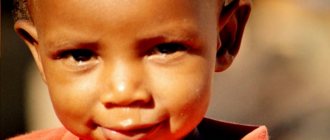Early development is a concept based on the statement that by the age of 3 the human brain is already 70% formed (according to other sources by 80%), and by 6-7 years - by 90%, and therefore many things the child needs to be taught before that age, otherwise he will not be able to master it at an older age.
This concept has become widespread; its followers can be found in many countries around the world. For example, you can read about this in Masaru Ibuka’s book “After Three It’s Too Late.”
Early development should not be confused with development in early childhood (from 1 to 3 years), since the approaches can be completely different and pursue different goals.
During early development, the child gains skills and knowledge that are usually acquired by children at later stages of development. These include the following skills:
- reading;
- mathematical skills (mental arithmetic);
- foreign languages;
- chess;
- speed solving a Rubik's cube;
- playing musical instruments, etc.
Benefit or harm depending on the organization of classes
The human brain develops unevenly:
- A newborn's brain contains about 200 trillion neurons (nerve cells), about the same as an adult's. The difference is in the number of dendrites and synapses, which are few at birth, but after the birth of a child, neural connections are formed very actively;
- The auditory analyzer is completely ready for functioning at the time of birth, the secondary zones of the cortex mature by 2 years; at 7 years of age, the auditory cortex is comparable to that of an adult;
- The visual analyzer is less mature at the time of birth, and the visual perception of a newborn, a one-year-old and a two-year-old child will differ greatly. The primary visual cortex matures only by 4 years, and the secondary by 7;
- The motor analyzer is also immature at the time of birth. The primary motor cortex matures only between 2 and 4 years of age. The secondary bark matures at 7-11 years of age.
- The association zones of the cortex (tertiary cortex) mature much later. The posterior association cortex (TPO area) matures by 11-12 years of age. The frontal cortex matures completely only by the age of 20-25 (researchers' data vary).
The main tasks in the development of a child of early childhood and preschool age are to provide an external stimulating environment so that the “lower” blocks of the brain can form the necessary connections and mature. Indeed, without inclusion in real activity, the corresponding zones of the cortex will be formed with a deficit. Not only physical health plays a role in the development of the central nervous system, but also lifestyle, environment, and family. A huge number of studies have been conducted that prove that if there are no external stimuli during the so-called sensitive period of development, then the parts of the brain involved in the process do not develop (and will never develop again). For example, the following experiment was conducted. Newborn kittens had one eye sewn up. The control group of kittens did not have their eyes sewn shut. After two months, the stitches were removed and the experimental group of kittens could again see with both eyes. But neuroimaging showed that the dendrites of the primary visual cortex were practically absent. That is, the neurons had no connections, and the kittens had so-called unilateral cortical blindness. The kittens could, but did not know how to see with the eye that was sewn up. Those areas of the visual cortex that were responsible for receiving and processing information from the unsutured eye developed normally. So did the visual cortex of kittens from the control group.
In humans, the first to develop are the cortical zones corresponding to the sensory and motor analyzers. And after this, the so-called associative zones, the tertiary cortex, are formed, which “builds on” the formed systems and unites them. With the help of these associative zones, a person can use speech, think abstractly in the absence of real objects, having their images in the head, build and understand complex verbal and symbolic formulas, including reading, writing and counting. If a child’s auditory analyzer is not sufficiently developed, then speech formation will occur with distortion. If the diagram of our own body is not formed, then the spatial representations with the help of which we operate with mathematical concepts and coordinate systems will be formed with a strong deficit. If you give tasks too early, the implementation of which is ensured by the tertiary zones of the cortex (reading, writing, counting), then the lower levels will not be formed properly.
A newborn child is able to distinguish phonemes of different language groups by ear, that is, the auditory analyzer develops faster than the visual one. Therefore, early learning of foreign languages is quite promising and does not contradict the natural development of the child’s brain, provided that the child’s nervous system is completely healthy and learning is based on hearing.
The idea of purposeful participation of adults in the development of a child in early childhood (1-3 years) and preschool (3-6 years) age is supported by all psychologists, however, there is no consensus on the effectiveness of classes and methods, since they largely depend on the teacher and the form of organization classes. In some situations, negative effects are possible, which are mainly associated with asynchrony in the development of various aspects of the psyche in children. Uneven processes of acquiring and mastering skills can lead to mental development delays, pathological acceleration, and underdevelopment of the motor sphere.
If you thoughtlessly and haphazardly teach a child all kinds of skills and knowledge, then the following negative consequences are possible:
- In the absence of communication skills and an independent value system, the acquired knowledge becomes a burden.
- A well-developed reading technique does not provide understanding of the text read.
- A good level of memory replaces thinking abilities and the ability to find solutions in non-standard situations.
- Mastering letters and numbers before the age of 5 distorts the process of forming the prerequisites for schooling, since the brain is not ready, for various reasons, to assimilate graphic symbols as a system. It turns out that those functions that should mature at an earlier age will not develop enough, hence the formation of a cognitive deficit. Example: the mother of a 9-year-old girl contacted our center, who taught her daughter to read from the age of three using Zaitsev’s cubes. As a result of applying the technique without taking into account the developmental features of interhemispheric interaction and spatial concepts, the child developed dyslexia and dysgraphia.
- A large vocabulary of foreign words is combined with a lack of understanding of simple words in the native language (the child cannot say that he is in pain or wants to drink). In such situations, a mixture of the native and the target language often occurs: “Mom, where is my swimwear?”
Thus, increasing cognitive load on a child’s immature brain without motor, sensory and play activities leads exclusively to the mechanistic application of knowledge. With high intellectual indicators, a child may turn out to be quite helpless in everyday life - not being able to dress himself or button a jacket, not knowing what to blow on something hot so as not to get burned, and so on. There may also be disturbances in vision, concentration, brain function, general mental depression and neuroticism of the individual.
Classes must follow a schedule. This is important for synchronizing the work of the hypothalamic-pituitary system (subcortical parts of the brain that are responsible for the level of activity, motivation for activity, sleep and wakefulness). External rhythm, including the daily routine, becomes a support for the formation of an internal system of signs in the future.
A regimen with a maximally planned day becomes especially relevant in preschool and primary school age. This is due to the fact that classes at school are held according to a certain schedule. In addition, at an older age, it is important for a child to master the regulation of his own needs, learn to consciously direct attention and engage in activities that are not always interesting, but necessary. This requires the ability to follow a schedule, and the ability to volitionally control one’s behavior appears at about 7 years of age. Each age needs its own regime, since at a certain stage of the child’s development different tasks are performed, and the child is monitored to varying degrees.
All-round development is important, so you shouldn’t devote all your time to just one thing (for example, learning languages or sports). It is recommended that one lesson be made up of five minutes with a change in the type of activity. We must not forget about physical development - gymnastics, swimming, dancing, etc.
The optimal schedule would be from 2 to 4 classes per week. At an early age, it is best to engage in one activity for 15 minutes, and then switch the child’s attention to another activity. This way he won't be overwhelmed with training. The older a child gets, the longer he will be able to concentrate on one thing.
At the same time, it is important to observe diversified development, and if on Monday training is devoted to languages, then on Tuesday it would be good to visit the pool, and on Wednesday to learn new animals, etc. The main thing is that there are not too many activities and that they correspond to the child’s level and interests. It is also important not to overload one analyzer. It is better to teach a child to perceive everything by ear at an early age. Now there is a big bias in vision, and the parts of the brain responsible for the visual analyzer mature later than the auditory ones, so asynchrony occurs. Before showing the image in the picture, you first need to let the object, animal, plant, fruit, etc. be seen. in real. An image is already a definite sign, and the sign system is formed on the basis of living sensory experience.
What to do with an eight-month-old baby
Time flies, and eight months have already passed since the birth of the child. How to develop a baby at this age? It is important to maintain his knowledge and stimulate him to acquire new skills. The development of the musculoskeletal system is one of the key tasks. Pediatricians recommend taking another course of massage by this time. If the baby's bones are ready, then at 8 months he already sits confidently on his own, while keeping his back straight, walking, holding onto support, falling and landing on his butt.
While awake, when the baby feels good and calm, you can captivate him by showing him various educational cards with images of animals, shapes, and colors. This is how we develop a child. From birth to one year, this technique has its own directions taking into account age and in the future can be actively used by parents as a game.
Alternative to early development
The most important thing in a child’s life is the process of play, so parents can organize his day and all activities in such a way that the child’s personality develops through play activities. The parent's task is to teach his child to distinguish and express his feelings, be able to interact with society and understand his needs. It is a mistaken opinion that if you create a schedule entirely of classes and developmental techniques, then the personality will be more developed. It is necessary from the parental figure to provide free time to assimilate the experience gained and the opportunity to demonstrate spontaneity in actions.
The urgent question remains that classes with a teacher differ from the time spent with parents. Names of streets, animals, flowers and increasing vocabulary is the task of an early development teacher. The tasks of parents boil down primarily to the following:
- sensorimotor development - games and exercises where the child develops various types of sensitivity, learns to navigate the surrounding space, develops large and fine motor skills;
- development of emotional intelligence through naming and articulating one’s own feelings, designating various emotional states of the child himself;
- remove restrictions on the manifestation of creative desires (when you want to draw, then let him draw, catch grasshoppers, knead clay) - the more the child has the opportunity to do what is interesting now, and not what adults offer, the better the imagination works later.
Parents should explore the world with their child, show him new animals, imitate surrounding sounds, and explain the various properties of objects. Only with such interaction is the practical application of the acquired knowledge possible. There must be elements of physical activity (running, walking on logs, climbing, etc.), as well as physical contact (hugs, tickling, swinging on arms, throwing up, etc.). This is necessary for the harmonious development of the entire personality and the activation of natural curiosity as the main driving factor of development.
Fourth month
An inquisitive baby is becoming more and more active and at this time he has to do a lot of things. He studies himself, so his hands go into his mouth as often as anything that happens to be nearby. At this stage, suitable educational games for children from birth (in particular, for a four-month-old baby) are:
- Developmental mats that will encourage your baby to roll over and reach up for a toy. The best place for this is to clean the floor.
- The crib can also become a place for developmental activities; at a distance of 30-40 cm from the baby, you can hang a baby mobile or rings that you can grab with your hands. The safety of the material from which they are made is an important point. If it is plastic, then such products are easier to care for. Textile educational mobiles will not cause harm; the baby will be able to crush them in his hand.
Nine months to a year
When we develop a child from birth to one year, we believe that a lot of time and money are spent on this. However, do not forget that most items are available and at hand, without requiring extra costs. Even habitual household manipulations are quite capable of captivating the attention of the baby. After all, this is all happening for the first time for him.
One of the important everyday skills is communication with adults; it can be developed with the help of simple movements, for example, waving your hand when saying goodbye or when meeting. Some parents note that at this stage the baby may require more attention from the mother. He already understands when she is around and when she is not. The fear of being left without her, even with friends and family, can greatly frighten him. That is why it is important that both parents participate in the process of raising a baby from birth. Developmental activities can keep a baby occupied and captivated for a long time, but even if he is busy when his mother leaves, under no circumstances should he leave secretly. Adults should teach the child to part with his mother and rejoice when meeting her. The child already understands a lot, he is easily occupied or distracted without being frightened by separation from his mother.








